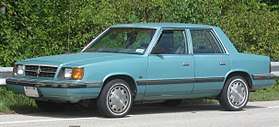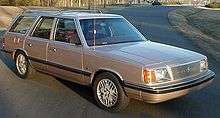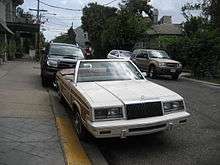Chrysler K platform
| K-platform | |
|---|---|
 1987 Dodge Aries K Sedan | |
| Overview | |
| Manufacturer | Chrysler Corporation |
| Production | 1981–1989 |
| Body and chassis | |
| Class |
Compact car Mid-size car Full-size car Sports car Minivan |
| Layout | FF layout |
| Body style(s) |
2-door convertible 2-door coupe 4-door sedan 4-door station wagon 4-door limousine |
| Powertrain | |
| Engine(s) |
2.2 l "2.2" 4 2.2 l Turbo I 4 2.2 l Turbo II 4 2.2 l Turbo III 4 2.2 l Turbo IV 4 2.2 l TC 4 2.5 l "2.5" 4 2.5 l Turbo 4 2.6 l Mitsubishi G54B 4 3.0 l Mitsubishi 6G72 V6 3.3 l EGA V6 3.8 l EGH V6 |
| Chronology | |
| Predecessor |
F-body J-body M-body |
| Successor |
PL JA LH NS |
The K-car platform was a key automotive design platform introduced by Chrysler Corporation in the early 1980s—featuring a transverse engine, front-wheel drive, independent front and semi-independent rear suspension configuration—a stark departure from the company's previous reliance on solid axle, rear-drive configurations. Derived from Chrysler's L-cars, the Plymouth Horizon and Dodge Omni, the platform was developed just as the company faltered in the market, at first underpinning a modest range of compact/mid-size sedans and wagons—and eventually underpinning nearly fifty different models, including all-wheel drive variants—and playing a vital role in the company's subsequent resurgence.
Common platforms
Use of a common platform is a widely used practice for reducing the number of parts and engineering time. Before creating the K platform, Chrysler was building vehicles from a small number of common platforms (e.g. F/L/J/M and R).[1] Lee Iacocca claimed that the huge number of parts in inventory and the complexity of building many completely different versions of vehicles was one reason Chrysler was losing money, and directed the engineers to focus on making a large number of common parts where they would not be visible to customers; this was already common practice in Japan and Germany and would help to make the K-cars profitable even at low prices.[2]
Arriving on the brink of Chrysler's near certain financial collapse, the new platform had a dramatic effect, helping Chrysler report a profit in October 1980 of $10 million, its first profit in two years.[3] A plethora of K-platform body styles and badge-engineered variants followed the original range, including the company's minivans and upscale Chrysler division models. The platform interchangeability saved production and purchasing costs, initially costing Chrysler $1 billion over three years to develop, but only costing $50 million to generate the second group of badge-engineered variants, the LeBaron and Dodge 400.[3] Within two years, the K platform vehicles accounted for roughly 50% of Chrysler's operating profits.[3]
In 1984, The New York Times said the K platform not only "single-handedly save(d) Chrysler from certain death, (it) also provided the company with a (platform) that could be stretched, smoothed, poked, chopped and trimmed."[3]
| “ |
We talk about all these cars being K car derivatives, which is correct, but that doesn't mean they all have to have K car characteristics. Through different selections of springs, shocks, tires, added sound insulation, improving rubber bushings, the character of the car can be changed quite dramatically. That has been the secret of being able to take a car of the K body compact class all the way up to the New Yorker luxury class. |
” |
In 1984, David Lewis, auto industry historian and professor of business history at the University of Michigan said no platform "in the history of the automobile industry has so dramatically allowed a company to survive in such a substantial way. No company has been down so low, in such difficult straits, and then depended on practically a single product to bring it back."[3]
Sales figures
Following the 1973 oil crisis, compounded by the 1979 energy crisis, American consumers began to buy fuel-efficient, low-cost automobiles built in Japan. With the market for large V-8 engined automobiles declining, American domestic auto manufacturers found themselves trying to develop compact vehicles that could compete with the Japanese imports of Toyota, Honda, and Nissan in price and finish. Chrysler Corporation's answer to the import pressure was the K platform, which featured an economical 4-cylinder engine, front-wheel drive, and used many modern weight-reducing measures such as replacing metal styling parts with plastic interior and exterior components.
The K-cars (Dodge Aries, Plymouth Reliant, Chrysler LeBaron, Dodge 400, and, in Mexico, Dodge Dart) sold over 2 million vehicles from 1981 to 1988, and around 100,000 in their final year, 1989.
The manual transmission provided acceleration of 0–60 mph (0–97 km/h) in 10 seconds, while the automatic was between 13 and 14 seconds, similar to or better than most competitors, while fuel economy was rated by the EPA at 26 mpg‑US (9.0 L/100 km; 31 mpg‑imp) city and 41 mpg‑US (5.7 L/100 km; 49 mpg‑imp) highway with the manual transmission. All had a 100.1-inch (2,540 mm) wheelbase. The overall length of the two- and four-door models was 176 inches (4,500 mm). The wagon was 0.2 inches (5.1 mm) longer. The vehicles had an approximate 14-US-gallon (53 l; 12 imp gal) fuel tank. The coupe and sedan had approximately 15 cubic feet (0.42 m3) of luggage space; the wagons, 35 cubic feet (0.99 m3) with the rear seat upright and about 70 cubic feet (2.0 m3) when folded down.
Numerous improvements to the sound insulation and general feel were made for the model year 1983. In 1985, the Reliant, Aries, and LeBaron received a facelift, with a rounded front fascia, smoother hood, and bigger taillights. In 1986, the cars began using fuel injection on the 2.2-liter engine and a 2.5-liter engine replaced the arguably unreliable Mitsubishi 2.6 liter engine, which was notorious for leaking oil and attracted to the cars nicknames like "Mr. Squishy" or "Bitsumishi."[4][5]
They were initially very profitable, and Chrysler chairman Lee Iacocca credited them with allowing the company to pay off its bankruptcy loans early.[2]
Derivatives


The K-derivatives offered a large variety of engines depending on year and model. Four-cylinder engines were initially equipped with carburetors; fuel injection was phased in beginning in 1986. Engine output ranged from 86 hp (64 kW) to 224 hp (167 kW). Most vehicles had the 2.2 l or 2.5 l Chrysler four-cylinder engine, though from 1981 to 1985 a 2.6 l four and from 1987 to 1995 a 3.0 l V6, both made by Mitsubishi, were offered. All had electronic ignition.
- K midsize cars
- 1981–1989 Dodge Aries (often referred to as the Aries K, owing to strong publicity for the K cars; 1981 models are badged as such.)
- 1981–1989 Plymouth Reliant (as above, also known as the Reliant K)
- 1982–1988 Chrysler LeBaron (coupes and convertibles were produced on this platform until 1986)
- 1982–1988 Chrysler LeBaron Town and Country
- 1982–1983 Dodge 400
- 1982–1985 Dodge Dart K (Mexico only)
- 1982–1985 Valiant Volare K (2-door) (Mexico only)
- 1986–1988 Dart by Chrysler (2-door and wagon) (Mexico only)
- 1986–1988 Volare by Chrysler (2-door) (Mexico only)
- 1986–1987 Volare by Chrysler (4-door) (Mexico only)
- 1983–1988 Plymouth Caravelle coupe (Canada only)
- 1983–1986 Chrysler Executive limousine
- 1984–1986 Dodge 600 coupe and convertible
- 1984–1987 Dodge Magnum 400 and Dodge Magnum Turbo (Mexico only)
- 1985 Chrysler 600 (Mexico only)
- E (Extended-wheelbase) mid-size cars
- 1983–1984 Chrysler E-Class
- 1983–1987 Chrysler New Yorker
- 1988 Chrysler New Yorker Turbo (For 1988, the non-turbo Chrysler New Yorker began using the larger C Platform (see below) but the Turbo did not)
- 1983–1988 Dodge 600 sedan
- 1985–1988 Plymouth Caravelle
- 1986–1989 Dart by Chrysler (4-door) (Mexico only)
- 1988–1989 Volare by Chrysler (4-door) (Mexico only)
- G sports cars (designated as the AG platform from 1989)
- 1984–1986 Chrysler Laser
- 1984–1993 Dodge Daytona and Chrysler Daytona (Canada)
- S minivans
- 1984–1990 Dodge Caravan
- 1984–1990 Plymouth Voyager
- 1990 Chrysler Town and Country
- H mid-size cars
- 1985–1988 Chrysler LeBaron GTS
- 1985–1989 Dodge Lancer
- 1987 Shelby Lancer
- P compact cars (designated as the AP platform from 1989)
- 1987–1994 Dodge Shadow
- 1987–1994 Plymouth Sundance and Duster
- 1987–1989 Shelby CSX
- J sport cars (designated as the AJ platform from 1989)
- 1987–1995 Chrysler LeBaron coupe and convertible
- 1988–1994 Chrysler Phantom coupe only (Mexico only)
- C mid-size cars (designated as the AC platform from 1989)
- 1988–1993 Chrysler New Yorker
- 1988–1993 Dodge Dynasty
- 1988–1993 Chrysler Dynasty (Canada only)
- AA mid-size cars
- 1989–1994 Chrysler Saratoga (Europe only)
- 1989–1995 Dodge Spirit
- 1989–1995 Plymouth Acclaim
- 1990–1994 Chrysler LeBaron sedan
- 1990–1994 Chrysler New Yorker (Mexico only)
- Q sports car
- 1989–1991 Chrysler TC by Maserati
- Y luxury cars (a stretched variant of the C platform used for two top-line models, also designated as the AY platform)
- 1990–1993 Chrysler New Yorker Fifth Avenue
- 1990–1993 Chrysler Imperial
- AS minivans
- 1991–1995 Chrysler Town and Country
- 1991–1995 Dodge Caravan
- 1991–1995 Plymouth Voyager
See also
- Metrication in the United States – First Chrysler car to be produced in the metric system with metric screw threads and components.
References
- ↑ "Rear-drive platforms". Allpar.com. 1978-10-05. Retrieved 2012-08-24.
- 1 2 Iacocca, L:"Iacocca"
- 1 2 3 4 5 6 "THE K CAR: VARIATIONS ON A THEME HELPED TO SAVE CHRYSLER". The New York Times. January 29, 1984.
- ↑ "Allpar/K-cars". Allpar.com. Retrieved 2012-08-24.
- ↑ Peter Cheney (2010-02-22). "10 worst cars chosen by our readers". The Globe and Mail. Retrieved 2012-08-24.